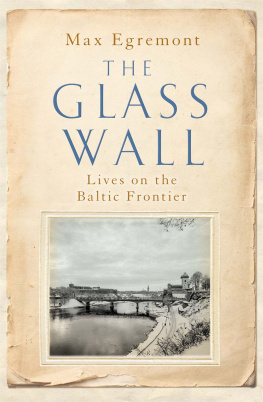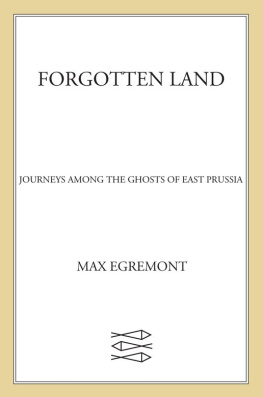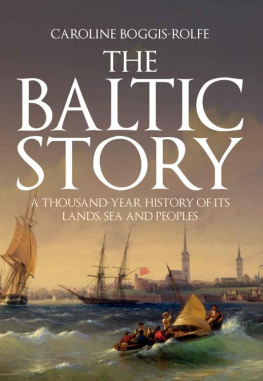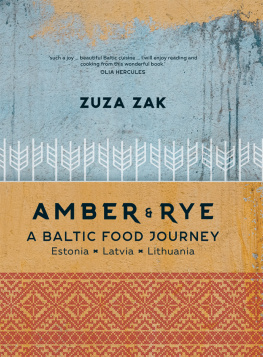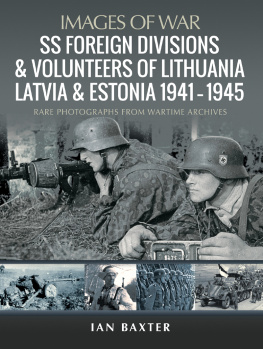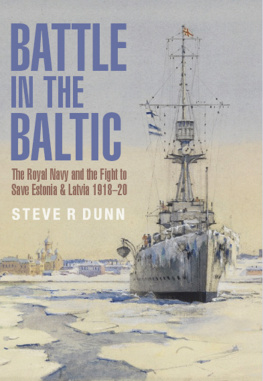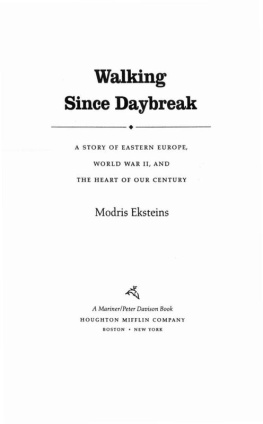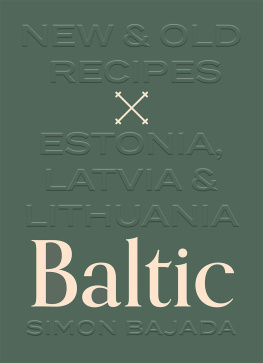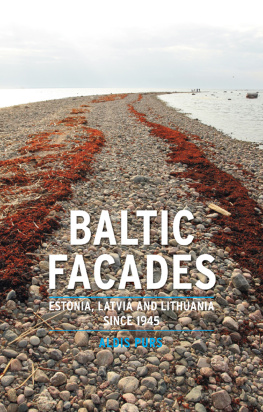M AX E GREMONT
THE GLASS WALL
Lives on the Baltic Frontier

For David and Alex Campbell
Contents
List of Illustrations

A Baltic Gazetteer
Many places mentioned in this book have had changes of name down the centuries from German or Russian to Latvian, Estonian or Finnish. The current name is shown first, then its predecessor if there was one.
Blumbergshof Baltic German manor house in the northern Latvian village of Lobrgi, near Smiltene (Smilten), lived in by the Vegesack family until 1939. The background to the childhood chapters of Siegfried von Vegesacks trilogy, The Baltic Tragedy (Die baltische Tragdie).
Csis Wenden Latvian town north-east of Riga on the Gauja River. Walther von Plettenberg, a German hero because of his sixteenth-century victories over the Russians, is buried there. The ruins of a crusaders castle are near the historic centre. At the Battle of Csis in 1919 Estonian and Latvian forces defeated General Rdiger von der Goltzs German troops.
Daugava River Dna in German and the Western Dvina in Russian. The River Daugava rises in western Russia, flows through Belarus, then into Latvia, through Daugavpils to the Gulf of Riga.
Daugavpils Dnaburg in German or Dvinsk in Polish and Russian. The largest city in Latgale, on the Daugava River. The birthplace of the artist Mark Rothko, the city had a large Jewish population until the German occupation during the Second World War.
Helsinki Helsingfors Capital of Finland. Finland became part of the Russian empire in 1809 and Helsinki shows the influence of imperial St Petersburg. Declaring independence in 1917, Finland was invaded by the Red Army in 1939 and in 1941 joined Germany in the Continuation War against the Soviet Union. From 1945 the country remained independent, wary of its giant eastern neighbour. Finnish television could be seen in northern Estonia during the Soviet years.
Hiiumaa Dgo The second largest Estonian island, where the Ungern-Sternberg family had large estates. The writer Aino Kallas had a summer residence there, as did the twentieth-century Estonian novelist Jaan Kross, who in the 1970s was considered for the Nobel Prize.
Ikile xkll Town on the Daugava River in Latvia and the site of the oldest church in the Baltics, built by the German monk Meinhard in the twelfth century. Nearby is the former German concentration camp at Salaspils.
Jelgava Mitau Formerly the capital of Courland and until its destruction in the Second World War a city of fine town houses and churches. On its outskirts is the former ducal palace, now the Latvian Agricultural University.
Kolga Kolk Manor house, once the northern Estonian home of the Stenbock family. It was to Kolk that the fin de sicle poet Count Eric Stenbock came to find his Baltic inheritance.
Kuldga Goldingen Thought to be one of the most beautiful towns in Latvia, Kuldga is west of Riga, on the River Alekupte, with a waterfall, wide rapids, a ruined castle, a historic centre, a former synagogue and fine baroque carving in the church.
Kurzeme Courland An area south-west of Riga, considered to be the most fertile part of Latvia. The Duchy of Courland existed from the sixteenth century until 1795 as a semi-autonomous part of the Polish-Lithuanian Commonwealth. There are surviving palaces at Rundle and at Jelgava. Courland was absorbed into the Russian empire in 1795, after the last partition of Poland, becoming the Kurzeme province of independent Latvia after 1918.
Latgale Vitebsk The most eastern Latvian province, influenced by its historic link to Poland, joining imperial Russia after the first partition of Poland in 1772. The most Roman Catholic part of Latvia, with a shrine at Aglona that is still a place of pilgrimage. Its largest cities are Daugavpils and Rzekne.
Lestene Lesten Latvian village west of Riga. The medieval church was much damaged during the war and is being restored. Next to the church is a large cemetery with a memorial to Latvians who fought for the Germans in the Second World War.
Liepja Libau Latvian port and resort on the Gulf of Riga. Karosta, the huge, decrepit former imperial Russian naval complex, consists of a vast Orthodox Cathedral of the Sea and a series of barracks, houses and forts.
Livonia The name given to what is now northern Latvia and southern Estonia, originating during the northern crusades from the Livonian people or Livs. Until the sixteenth century, Livonia referred to virtually the whole of what are now Latvia and Estonia.
Palmse Palms Estonian manor house east of Tallinn, formerly owned by the von der Pahlen family. Now a museum that shows the life and workings of a Baltic German estate and the familys service to the imperial government in St Petersburg.
Prnu Pernau Coastal resort in Estonia with a museum that has ancient archaeological remains. There is a large cemetery with tombs and graves of families such as the Schmidts that were involved in the trading of flax, timber and other commodities.
Lake Peipsi Peipus One of Europes largest inland lakes, on the frontier between Estonia and Russia. In 1242, it was the scene of a winter battle when Prince Alexander Nevskys Russian army defeated the Teutonic Knights. There is a community of Russian Old Believers on the lakes Estonian shore.
Pltsamaa Oberpahlen A town in Estonia, south-west of Tallinn. The thirteenth-century castle was made into a new residence with rococo interiors in the eighteenth century by its owner Johann von Lauw. The mansion and much of the town were destroyed in an air raid in 1941. The church was restored after the war.
Narva Narwa Town on the northern border between Estonia and Russia. The River Narva divides the Estonian bank, with its medieval castle (built originally by Danes), from the Russian town and fortress of Ivangorod.
Regen German town on the River Regen in the Bavarian forest. A medieval tower there was discovered in 1917 by the Baltic writer Siegfried von Vegesack. From 1945 until 1991 Regen was near the frontier with Soviet Europe or what was then Czechoslovakia.
Rzekne Reica or Rositten The capital and second largest city in the Latvian province of Latgale. Badly damaged during the Second World War, Rzekne has a Roman Catholic cathedral and ruins of a crusaders castle. Nearby is the Roman Catholic shrine of Aglona, a place of pilgrimage.
Riga Riga The present capital of Latvia. In 1201, Bishop Albert von Buxhoeven founded the city, ordering the building of the cathedral as part of the northern crusade. During the Swedish era, consideration was given to moving Swedens capital to Riga from Stockholm. After King Charles XII of Swedens defeat by Peter the Great in 1709, Riga became part of imperial Russia. The Englishman George Armistead was mayor from 1901 until 1912. Outside its medieval centre, Riga has one of the largest collections of art nouveau buildings in Europe.

